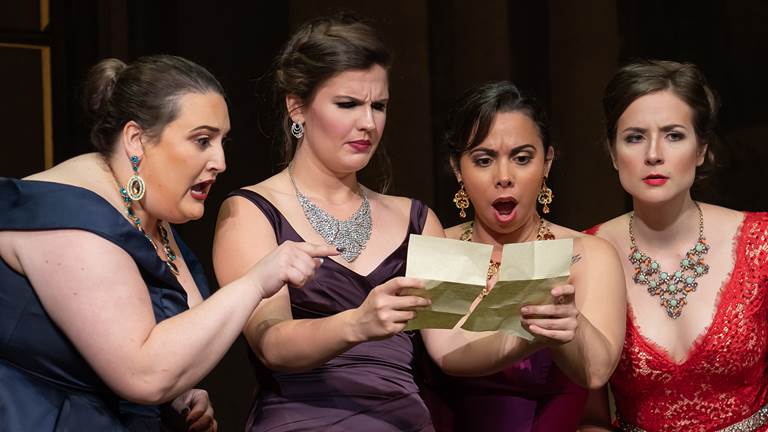Attempting to capture the thought-provoking messages and poetic dimensions of The Grapes of Wrath in a Hollywood film must have been a challenging feat. In many ways, the attempt to capture these magnetic qualities of The Grapes of Wrath in operatic form must have been even more daunting. Film, for instance, can image the reality of a landscape, can augment dialogue with camera angles, and/or with close-ups of facial expressions or other camera “tricks”. Opera, however, is confined to a stage environment and much of the delivery of events, overt expressions and undercurrents of themes and emotions of the text must be projected in musical idiom.
But in February, 2007 The Minneapolis Opera Company, in conjunction with the Utah Symphony and Opera, took on that extra challenge, and based on the high praise given in critical reviews of the original and later performances, including a concert version at Carnegie Hall, the opera of The Grapes of Wrath was a big success. How would you have approached transforming the text into an opera? The following questions and activities are crafted to help you think through an approach in preparation for sketching out your own conceptual plan for an opera version of the text.
Step 1: Getting Started
What distinguishes opera from other forms of dramatic and musical productions? To help clarify that distinction, explore some of the historical background of opera. The ARTSEDGE Web link, a “Brief History of Opera”, is an excellent source.
To provide a frame for initiating the transforming process, record in your notes a brief explanation of the following key elements that govern the development and performance of opera. Clarify what purpose each element would serve in reconstituting the text in opera form.
structural segments of the libretto:
- overture
- recitative
- arias
- duet
- trio
- quartet
- chorus
types of vocal range:
- soprano
- mezza-soprano
- contralto
- tenor
- countertenor
- baritone
- bass
voice classification:
- coloratura
- voice weight
- tessitura
use of ensemble
other?
Step 2: Shaping the Plan
An initial decision in turning The Grapes of Wrath into an opera is determining the structural framework you are going to follow in developing the libretto. A major consideration is whether or not you will follow the structural sequence of the text or redesign the structural plotting.
To help work through decisions concerning the structural plan, collaborate with a partner(s) to reach conclusions about such aspects as:
- opening and closing the opera
- establishing the Dust Bowl environment for the audience and later environments the Joad family encounter en-route and in California
- shaping transitions
- selecting of emotional high points you would particularly showcase
- deciding what elements would be compressed; what elements expanded
The above considerations could be augmented by thinking through the fabric, the modes of presentation. For instance,
- what parts of the structural development would be recitative?
- would you use a narrator?
- where/how would the emotional high points be embedded within the
- framework of your conceptual plan?
- what segments would lend themselves to duets, trios, quartets, if any?
All of the above considerations could help you narrow to another level of decision-making:
- what specific elements of the content of the text would be handled by the ensemble? (thinking through the various purposes the Chorus served in Ancient Greek Drama could help with this decision)
- who of the characters would sing arias? why?
- in what specific ways could spatial designs for staging reinforce various content elements and/or high points of the text?
- how could the structure, fabric (voices, movement, timing, costuming, sets, lighting, etc.), and stage placement of presentation be organically interwoven to clearly project the transcending theme of the novel in a dynamic way
The above suggestions mainly address the development of the libretto of the opera. Other factors also come into play in thinking through the performance elements of the opera. For instance, consider that an opera, including any narration, recitative delivery, music score, and lyrics are woven with an intricate mix of the elocutionary reflections that govern elements of logic and tone quality in everyday speech: declarative; interrogatory; imperative; exclamatory.
With that in mind, select vignettes from of the text of The Grapes of Wrath that, in your perception, are individual examples of each of the above elocutionary patterns. Then determine the mode of presentation you would designate for each example. Should the selection be delivered in narration? Speech dialogue? Through song rendition? Or a combination of both (recitative and song)?
A prime element to the success of performance of an opera is the matching of voice quality of performers to the individual characters in the libretto. Give thought, in shaping your conceptual plan to that alignment. This “match” would be closely aligned to your close analysis of the “persona” of each character as he or she emerges in the text and with the “thesis” of the lyrics to be delivered in song.
Other layers of performance planning would involve decisions on stage sets, costuming (particularly whether or not costuming would be monochromatic or have textures of color, lighting, special effects (for instance, to punctuate the time period and nature of cultural elements underscoring the text)
Step 3: Going Beyond
Consider selecting, as a collaborative special project, one brief segment from your conceptual plan of a libretto based on the text to develop into an operatic performance, complete with original music score, lyrics, stage properties, costuming.
Ideally, three or four collaborative teams could select different passages of their libretto plan to turn into originally scripted “live” performances.
After the original scripts have been shaped and performed, consider viewing vignettes of the Minneapolis Opera Company performance of The Grapes of Wrath posted on the Web.


